Archive for category July 2011
Tropical Forest India — Phipps Conservatory’s Ambitious Project
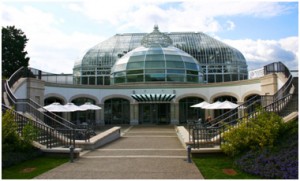 The Phipps conservatory is an Oakland landmark well-known nationally for its collection of exotic tropical plants in an aesthetically laid out greenhouse. No wonder it is a popular spot for weddings.
The Phipps conservatory is an Oakland landmark well-known nationally for its collection of exotic tropical plants in an aesthetically laid out greenhouse. No wonder it is a popular spot for weddings.
A team of Phipps’ staff and volunteers led by its Tropical Forest Curator Ben Dunigan and Horticulturist Jordyn Melino is gearing up for Tropical Forest India, a 3-year long — February 2012 to February 2015 — exhibition of live species from India’s diverse tropical forest along the Western Ghats stretching from Gujarat all the way to the southern tip of Kanyakumari along the Arabian sea coast.
Nearly 800,000 visitors are expected to come to the exhibition. In addition to live exhibits including medicinal plants, we are also likely to have multimedia presentations on the area’s flora, fauna, temples, and peoples. More details will be forthcoming in coming months. Visit www.phipps.conservatory.org for additional details.
     — Kollengode S. Venkataraman
Raja Wins in the Republican Primary
Uphill contest in November against Rich Fitzgerald (D)
By Kollengode S. Venkataraman
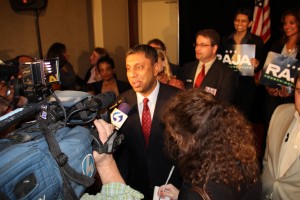 D. Raja, the president of Mount Lebanon city council and known to many readers, won the Republican nomination for the office of Allegheny County’s chief executive in the May 16 primary election. He easily defeated the old-time Republican pol Chuck McCullough.Â
D. Raja, the president of Mount Lebanon city council and known to many readers, won the Republican nomination for the office of Allegheny County’s chief executive in the May 16 primary election. He easily defeated the old-time Republican pol Chuck McCullough.Â
Raja, a relatively unknown figure in the county’s electoral politics, will face his Democratic opponent Rich Fitzgerald, another entrepreneur, a very native son of the county. Fitzgerald is also a 11-year veteran in the Allegheny County Council, with seven years as the council president.
Raja, born in Bangalore and raised in Bangalore and Chennai, came to the University of Pittsburgh in 1986 with his bachelor’s degree in electrical engineering to earn his MS in computer science. He started his own IT consulting company, now known as CEI America founded in 1992 that employs around 300 in the US and another 100 in India. CEI now has many Fortune-500 companies as clients. Along the way, he also earned an MBA from CMU. In 2007, Raja was elected the commissioner from Ward 1 in Mt. Lebanon. He became the president of the council in 2010, which he resigned to contest the fall election. Â
For the successful and first Indian-American entrepreneur with ambition to become Allegheny County’s chief executive, getting the Republican nomination was the easy part. After all, Raja had the endorsement of the party’s heavyweights here — Governor Tom Corbett; US Senator Pat Toomey; Congressmen Tim Murphy and Mike Doyle; state house majority leader Mike Turzai; and Jim Roddey, the first chief executive of Allegheny County; among others.Â
Chuck McCullough’s legal problems and that McCullough’s previous boss Jim Roddey himself endorsed Raja only made it easy for Raja in the primary. McCullough, a known figure in county electoral politics, is facing criminal charges of taking money from his elderly woman client and donating the moolah without her approval. His cash-strapped campaign and rains on the election day pretty much sealed McCullough’s defeat.
The job is cut out for Raja between now and November when he faces Rich Fitzgerald, his Democratic opponent. Governor Corbett’s endorsement, which helped Raja win the Republican primary, could become the liability in November, given the unpopularity of the Governor just months after taking office. Pennsylvania’s ultraconservative US Sen. Pat Toomey’s endorsement too is a problem for Raja among the middle-of-the-road voters, not to speak of liberals. Besides, in Allegheny County, among registered voters, for every two registered Republicans, we have five registered Democrats. That is perhaps why no credible “mainstreamâ€Â Republican even sought the nomination.Â
After the primary elections, Marty Griffin, the host of the morning talk show on KDKA Radio, interviewed Raja giving him opportunities to introduce himself to his listeners. Griffin was candid: Running an IT business as its Founding CEO is one thing, he said, where you are free to make all the decisions and even change the decisions. But in municipal government there are many deeply entrenched competing interests. And the Chief Executive’s writ will not go far if he cannot carry with him the majority of the county’s cantankerous council members.
Besides, running a financially strapped county that encompasses over 120 municipalities including the “Most Livable†City of Pittsburgh, many of them in deep financial hole, offers a list of challenges. After all, these municipalities fight among themselves like the petty City States in ancient Greece.
Raja (as of June 15, 2010) was yet to come with the specifics on what he sees as the challenges, and how he is going to address them.
Listening to Griffin’s talk show was “educational.†His “birther†listeners were wondering if Raja was born in the US to be eligible to contest the election. So, Raja will have to start at the very beginning in educating voters without appearing preachy that one does not have to be a natural citizen to contest the election even for the US Senate. Given that our region is very parochial — this is Post-Gazette’s veteran columnist Reg Henry’s assessment*, not mine — it was not surprising.
Griffin’s listeners were also uncomfortable with Raja’s simple two-consonant two-syllable name containing only one vowel. And his accent. And his faith as well, even before they even cared to know what his faith was.
 This is nothing new in the US. Ask President Obama. Or ask Republican Mitt Romney. Many Republicans are uncomfortable with Mitt Romney’s Mormon faith.
Obviously, our voters have lot of room to grow. And as Indian-Americans, we too need to come out of our suburban enclaves, and niches in universities, hospitals, corporate world, and other organizations and make average voters accept us as one of them.Â
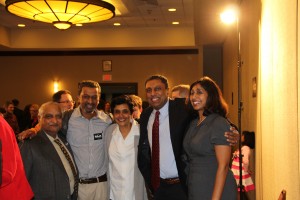 For winning, Raja has to succeed in persuading a large number of liberal Democrats to defect and social conservatives among voters to vote for him. One wonders which is more difficult. He has a steep hill to climb between now and November. Mercifully, he will be unencumbered with the biennial Congressional elections and the quadrennial presidential elections. In this election, he is flying solo with no Republican coattail effect. Nor will he have a strong Democratic headwind. But the 5-to-2 margin of registered Democrats over GOP in the county, and Fitzgerald’s home-grown background are formidable enough.
For winning, Raja has to succeed in persuading a large number of liberal Democrats to defect and social conservatives among voters to vote for him. One wonders which is more difficult. He has a steep hill to climb between now and November. Mercifully, he will be unencumbered with the biennial Congressional elections and the quadrennial presidential elections. In this election, he is flying solo with no Republican coattail effect. Nor will he have a strong Democratic headwind. But the 5-to-2 margin of registered Democrats over GOP in the county, and Fitzgerald’s home-grown background are formidable enough.
The contest will be between the Republican Raja and his Democratic opponent Rich Fitzgerald on their own individual strengths and weaknesses. We wish Raja all the best in the fall election and even beyond.
 * This is how Reg Henry, a 30-year veteran columnist in the Post Gazette characterizes our citizens’ parochialism: “This is one of the most parochial towns I have ever lived in… … We encountered several candidates who did not just live in the same neighborhood they grew up in, they lived in the same house.â€
Jack Kevorkian: Trailblazer on End-of-Life Issues
 Dr. Jack Kevorkian, who, by his in-your-face approach brought to the forefront the plight of terminally ill patients’ right to die in dignity when they have no options to live with dignity and autonomy, died in May. He was 83. In the 1990s he brought to the fore the inability (or is it unwillingness?) of our society at large — the medical establishment, the legislature, the clergy, law enforcement authorities, and the judiciary — to come to grips with the agony of not only the terminally ill people, but also their care-givers.
Given our compartmentalized lifestyle, people cannot comprehend the sense of deprivation and the deeply personal pain the terminally ill suffer; and the agony of those closely living with the terminally ill taking care of them 24/7.
We admire modern medicine for coming up with new procedures, medicines, and gadgets for finding cures for scores of illnesses and extending our productive lives; but in the end, these marvels also simply prolong life without addressing the issues on the basic human dignity and autonomy of patients, and the associated cost. So, it was necessary that Kevorkian used unorthodox approaches to bring the central issues of the terminally ill in public discourse. Indeed, his approach was very effective.Â
As the New York Times said in its obituary to Kevorkian, “In arguing for the right of the terminally ill to choose how they die, Dr. Kevorkian challenged social taboos about disease and dying while defying prosecutors and the courts.â€Â He helped 130 terminally ill people to end their lives. His critics called him Dr. Death. He was convicted of second degree murder in the death of his last patient. Sentenced to 10 to 25 years in a maximum security prison, Kevorkian was released after spending eight years in prison after agreeing not to help others to end their lives.
Jack Lessenberry, the Michigan journalist who covered Dr. Kevorkian, wrote in The Detroit Metro Times: “Jack Kevorkian, faults and all, was a major force for good in this society. He forced us to pay attention to one of the biggest elephants in society’s living room: the fact that today vast numbers of people are alive who would rather be dead, who have lives not worth living.â€
Kevorkian’s crusade on behalf of the terminally ill led to the growth of the hospice care industry with improvements in the quality of care. The medical establishment itself changed its approach to pain management. And Oregon even legalized medical ending the life for the terminally ill, and removed the criminality and social stigma for their decision.
The central issue for which Kevorkian fought is only going to become acute in the years ahead, with an even more aging population, and reduced government resources available for Medicare for the elderly and Medicaid for the poor. One day, society will even thank Kevorkian for bringing to the forefront the dilemmas and challenges faced by the terminally ill.
We are honored to do it today itself. Thank you, Dr. Kevorkian.
 — K S Venkataraman
India’s US Ambassador Meera Shankar Sees Further Strengthening Indo-US Ties
By Kollengode S Venkataraman
India’s ambassador to the US, Ms. Meera Shankar, in her address to a gathering organized by the World Affairs Council of Pittsburgh covered many topics her diverse audience of US business executives, Indian entrepreneurs, academics, and Indian-Americans wanted to hear.
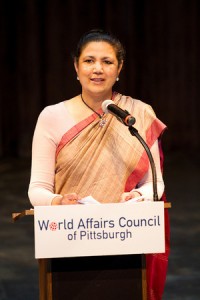 Addressing nearly 150 people on Thursday, April 28 at the New Hazlett theater in North Side, Shankar said, after the improved Indo-US relationships during the past several administrations in US and India, President Obama’s and Prime Minister Manmohan Singh’s state visits are new milestones.
Addressing nearly 150 people on Thursday, April 28 at the New Hazlett theater in North Side, Shankar said, after the improved Indo-US relationships during the past several administrations in US and India, President Obama’s and Prime Minister Manmohan Singh’s state visits are new milestones.
On terrorism, Shankar said India and US, both constitutional pluralistic democracies, are vulnerable — Indian more so than the US given the history of the subcontinent. Naturally, both US and India, she said, are committed to counter terrorism in Pakistan and Afghanistan. India wants a stable and prosperous Afghanistan, she said, simply because an unstable Afghanistan, the corridor between the oil and gas rich Central Asia and the energy hungry India, brings problems for the whole region. Another factor is Afghanistan’s untapped mineral wealth. For the same reason, Pakistan also wants control the region. India is working with Afghanistan on farming, women’s empowerment, and education an other areas.
On India’s economy, she said, India’s growth rate even during the recent recession was a respectable 6%, which has bounced back to over 8% now. It is one of the high growth rates among nations. India’s growth, driven as much by internal demands, smoothens the impact of the wide swings in global economy on India. So, she sees opportunities for cooperation in areas of mutual interest in trade and technologies in pharmaceuticals, steel, and IT, defense- and security-related areas.
Even though in terms of absolute numbers trade with India does not rank high in the US foreign trade, there are great opportunities for growth. US exports to India rose by nearly 300% over the last decade. (Note: For 2010, US exports to India is $19 billion, imports from India is $29 billion. US export to China is in a very different orbit: Export to China $90 billion, import from China is $360 billion).
While US is now the source for the largest overseas direct investments in India, Indian businesses, too, have started investing in US in energy and other sectors. In spite of the spectacular growth stats, Shankar candidly acknowledged the widespread poverty in India, and the benefits of growth not percolating to poor people, which, we should say, has the potential for triggering social unrest.Â
While 60% of India’s population depends on farming, farming accounts for only 20% of India’s GDP. India, she said, still remembers the acute food shortage of the 1960s, which lead to the first Green Revolution with help from American agronomists. Given the history of famine in the Indian subcontinent and the severe malnutrition among children from low-income and poor families even today, it was not surprising that Shankar said, “Food security is important to India’s national security, and this reflects in Indo-US relationships.â€Â
On India’s energy needs, while conceding the impact of fossil fuel on climate change, she said both India and the US depend on fossil fuel to a great extent. She said India is committed to clean and renewable technology for meeting India’s energy needs. While citing the example of two nuclear power plants to be built in India with US technology, Shankar said, rather incredulously, that nuclear energy is environmentally friendly.
While Indo-US defense cooperation is strong as seen by the increasing defense purchases from the US, Shankar said, India wants to diversify its defense procurements.
After the formal address, Shankar fielded several questions from the audience covering a whole range of issues.
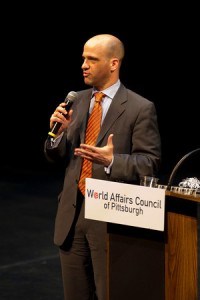 David Murdoch, Managing Director, and Stevel Sokol, President of WAC of Pittsburgh (shown in the adjacent picture intoducing Ambassador Shankar)Â also addressed the gathering. Sunil Wadhwani introduced the ambassador to the audience. Dennis Lobonski of Allegheny conference on Community Development also briefly talked about foreign direct investment opportunities in Pittsburgh.
David Murdoch, Managing Director, and Stevel Sokol, President of WAC of Pittsburgh (shown in the adjacent picture intoducing Ambassador Shankar)Â also addressed the gathering. Sunil Wadhwani introduced the ambassador to the audience. Dennis Lobonski of Allegheny conference on Community Development also briefly talked about foreign direct investment opportunities in Pittsburgh.
During her visit Ambassador Shankar also met with Governor Tom Corbett and County Executive Dan Onorato. She visited Carnegie Mellon University and the University of Pittsburgh and met with their officials.
World Affairs Council of Pittsburgh with support from the Allegheny Conference on Community Development and Pittsburgh Regional Alliance organized the event. Aquatech, BNY Mellon, Bombardier, PNC Hawthorn, Koppers, Heinz, Westinghouse, and UPMC sponsored the event, among other companies having business interest in India.
Next day Lalit Chordia of Thar Technologies hosted a private reception to the ambassador at Phipps Conservatory, where its Assistant Curator Ben Dunigan told the ambassador and the invited guests that they are working on an ambitious project titled Tropical Forest India. This will feature live exhibition on India’s (and Asia’s) centuries old technique of cultivating several commercial crops in the same physical space, which modern agronomy calls “intercropping.†See details on page 21.  n
Silk Screen Gala-6 Scintillates Again
by Sandhya Krishnan       e-mail:  sandhyakrishnan@gmail.com.
Sandhya Krishnan works at the corporate office of the famous local grocery chain, often moonlighting as the founder-director of Blue Mango – a multi-ethnic theatre group based in Pittsburgh. Having done two plays in the last two years, she is currently working on the third. Sandhya is an alumnus of BITS Pilani and XLRI Jamshedpur and lives with her husband in the beautiful Squirrel Hill neighborhood. Â
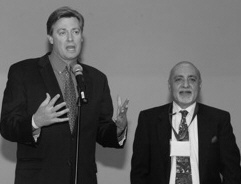 Getting a diverse, colorful and well-connected crowd together is no easy feat and Executive Director Harish Saluja seems to pull it off effortlessly every single time. On May 6 2011, The Silk Screen Festival team hosted their Annual gala at the Omni William Penn hotel and an estimated 300 patrons showed up in their ethnic best.
Getting a diverse, colorful and well-connected crowd together is no easy feat and Executive Director Harish Saluja seems to pull it off effortlessly every single time. On May 6 2011, The Silk Screen Festival team hosted their Annual gala at the Omni William Penn hotel and an estimated 300 patrons showed up in their ethnic best.
Drawing attention were Kathy and Sean Engel, attired in Indian traditional wear. Sean was seen sporting a bridegroom look from Udaipur, complete with a glittering turban, while Kathy paired her turquoise Jaipur saree with jewelry from Delhi. “We love Asian culture†said Kathy, adding that they plan to celebrate their anniversary by catching some of the movies at the festival.
The selection of food was diverse too, from Indian fare from Taj Mahal and Mediterranean from Alladin’s to Thai from my favorite place, Thai Cuisine. Several lovely pieces of origami made up the décor while a length of the room was lined with auction items. Inspired, I followed the kimono route to meet Kumiko Lancet and her team. Every year they are a part of the festival and this time they were the prelude to the main event. Their band of singers and musicians entertained the crowd with traditional Japanese songs from 7.30-8.00 pm.
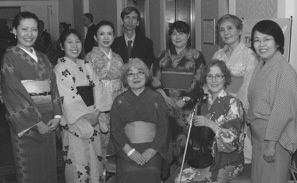 The entertainment was interesting and new, though from what I heard some pieces made a repeat appearance. As excited I was to see the myriad performances, I thought the artistes deserved more attention, either by the layout of the room or by having the audience seated.
The entertainment was interesting and new, though from what I heard some pieces made a repeat appearance. As excited I was to see the myriad performances, I thought the artistes deserved more attention, either by the layout of the room or by having the audience seated.
I love that Silk Screen is a part of our art scenario in Pittsburgh. The movies are always exciting, the marketing is great and the festival is one the city looks forward to every spring. And the gala, besides being a well-attended gorgeous evening, stood testimony to the fact that success comes in all colors!
Editor’s note: Nominated by Katie Jones of Silk Screen, Harish Saluja was chosen by UPMC Center for Inclusion as the Dignity and Respect Champion for May 2011 for fostering understanding across lines of race, ethnicity, religion, age, and region through Silk Screen. n
When the Quake Hit Japan: A Nuclear Engineer’s First-Person Observations
By Urmimala Shome   e-mail: sango83@gmail.com
 Editor’s Note: Born in Kolkata, India, Urmimala Shome came to Pittsburgh, PA, when her parents moved to Pittsburgh, over 25 years ago. She was five years old. She grew up in Pittsburgh earned her mechanical engineering degree from Carnegie Mellon, and is working in the commercial nuclear power industry since June 2005. After working as an Accident Analyst at Westinghouse Electric for five years she moved to Mitsubishi Heavy Industries (MHI) last year as a Severe Accident Analyst. She was in Japan on work when the quake hit. She lives in Arlington, VA.
Editor’s Note: Born in Kolkata, India, Urmimala Shome came to Pittsburgh, PA, when her parents moved to Pittsburgh, over 25 years ago. She was five years old. She grew up in Pittsburgh earned her mechanical engineering degree from Carnegie Mellon, and is working in the commercial nuclear power industry since June 2005. After working as an Accident Analyst at Westinghouse Electric for five years she moved to Mitsubishi Heavy Industries (MHI) last year as a Severe Accident Analyst. She was in Japan on work when the quake hit. She lives in Arlington, VA.
I was at work when the quake hit. I was jotting down some mundane project schedule reminder when, all of a sudden I started to feel dizzy and nauseous. Then I noticed the window blinds swaying back and forth like a pendulum. “Ah, my first Japan earthquake,†I thought. My first international quake really, as I had lived through several smaller ones during my short stay in California. Several minutes passed. I began to realize that the rocking motion (like ones on a boat in choppy weather) had not subsided or reduced in intensity. Most of my Japanese teammates were congregating at the windows and peering out at the ocean. At the time of the quake, I was working out of Kobe, a port city on the Pacific Coast, located in southwestern Japan. Mitsubishi’s Energy & Transportation Division is located at the MHI Shipping yard, right next to the ocean.
 About five whole minutes passed since I first noticed the first sign of a quake. During those minutes, I had been giving a play-by-play of the situation to friends back in California via g-chat. I immediately went on the USGS.org site, reading about the time, location, and magnitude of the quake. Preliminary readings put it at 7.9 on the U.S. Richter scale, the epicenter approximately 900 km (~560 miles) northeast of Kobe. The final reading placed it at a 9.0.
About five whole minutes passed since I first noticed the first sign of a quake. During those minutes, I had been giving a play-by-play of the situation to friends back in California via g-chat. I immediately went on the USGS.org site, reading about the time, location, and magnitude of the quake. Preliminary readings put it at 7.9 on the U.S. Richter scale, the epicenter approximately 900 km (~560 miles) northeast of Kobe. The final reading placed it at a 9.0.
Japanese zoning and construction laws are strict about building on earthquake-prone  sites. Modern buildings are designed to sway during a quake, and absorb the kinetic energy of the moving ground. Your sways and the displacements you experience depends on how far you are above the ground, on what floor you are on – the higher you are, the more sway you will feel. My group is located on the eighth floor of a 12-story building, so we definitely felt our building rock back and forth.
sites. Modern buildings are designed to sway during a quake, and absorb the kinetic energy of the moving ground. Your sways and the displacements you experience depends on how far you are above the ground, on what floor you are on – the higher you are, the more sway you will feel. My group is located on the eighth floor of a 12-story building, so we definitely felt our building rock back and forth.
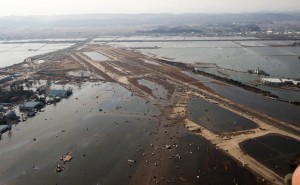 Soon after the initial quake stopped, the aftershocks started; two were almost as severe lasting almost as long as the initial tremor. Since the epicenter was out in the sea, Kobe was at risk of being hit by a tsunami. About ten minutes after the end of the second aftershock, we were told to evacuate in response to a tsunami warning. But Kobe was spared  any tsunami effects.
Soon after the initial quake stopped, the aftershocks started; two were almost as severe lasting almost as long as the initial tremor. Since the epicenter was out in the sea, Kobe was at risk of being hit by a tsunami. About ten minutes after the end of the second aftershock, we were told to evacuate in response to a tsunami warning. But Kobe was spared  any tsunami effects.
For a entire week after March 11th, I was on the phone, e-mailing, and Skyping with family and friends trying to reassure them of my safety. I initially did not plan to return to the U.S., but decided to do visit my family who were understandably worried sick.Â
Throughout this week, news coverage of the Fukushima Daiichi nuclear plant situation was in full swing. Working in the commercial nuclear power industry for the past six years, of course, gave me better understanding into the technical aspects of the accident in the four reactors. It was interesting for me to see how the situation was explained to the public.
There was a definite contrast between Japanese and American reporting. Watching CNN that first night, I was rather disappointed with the lack of accurate reporting in the U.S. I soon turned CNN off and started reading Al Jazeera, BBC, World Nuclear News, and the NRC sites online. I soon instructed my family and friends to follow suit.Â
American news programs sensationalized about 90% of their coverage of Fukushima. Instead of trying to explain basic principles of how nuclear energy is generated or even the layout of the inside of these types of reactors, reporters felt the need to politicize the future of nuclear power in general by comparing the accident to Chernobyl and Three Mile Island. They were falsely claiming that Fukushima was “another Chernobyl,†which is not only inaccurate, but also unethical because that comparison propagated rampant misinformation. Instead of calm, collected, and objective journalism, the American public was misinformed with anti-nuclear energy rhetoric and propaganda. The Japanese reporting was more objective. Specifically, the NHK news anchors kept table-top models of the inside of the Fukushima reactor to help explain the phenomenon inside the plant. They interviewed the electric utility company officials who owned the reactor as well as the civilians impacted by the evacuation. In the first weeks after the quake, NHK reporters focused on trying to be as informative as possible, without commenting on the politics of Japan’s nuclear power.Â
Outside of the news coverage, I was rather impressed by the level of calm and preparedness shown by the Japanese people. Their response was one of seasoned veterans facing yet another natural disaster. Of course, this quake was singularly worse because the huge quake was coupled with tsunami, which destroyed a nuclear plant, leading to radiation exposure.Â
Had something of this magnitude happened anywhere else in the world, especially in the U.S., it is entirely possible that we would have had much more mass panic and disorder. The aftermath of Hurricane Katrina provides a good example. The widespread looting during Katrina was starkly different from the dignified and respectful way that the Japanese people treated one another. There seemed to be a real sense of community and camaraderie from the very start in the wake of the great calamity.
As a result of this level of cooperation, the impacted region of Japan is now steadily recovering. However, the question remains, what is the fate of nuclear power in Japan and rest of the world? There are many lessons to be learned from Fukushima. The worldwide nuclear community must be given the opportunity to apply those lessons learned to new plan construction.
It is clear that the much-lauded “nuclear renaissance†can no longer go full-steam ahead. Already, all of the world’s nuclear reactors are being inspected again, and have been either modified or shut down as a result.
There is no doubt that the accidents at Fukushima have shaken people’s confidence in nuclear power. Going forward, it is the responsibility of the nuclear industry to convince the public that nuclear power is safe, and still has a future in our world. So we are taking it one day at a time. n
Obituary: James White – May 1941 to April 2011
Curator of Botanical Library at CMU and an Avid Lover of Indian Music and Visual Arts
 James White, the very soft-spoken curator of Botanical Documentation at Carnegie Mellon University’s Hunt Library, and a great lover of Indian performing and visual arts, died on April 12, 2011 in the wake of an accelerating degenerative neurological disease. He was 69.
James White, the very soft-spoken curator of Botanical Documentation at Carnegie Mellon University’s Hunt Library, and a great lover of Indian performing and visual arts, died on April 12, 2011 in the wake of an accelerating degenerative neurological disease. He was 69.
White, born and raised in Johnson City, Tennessee, earned his bachelor’s degree from East Tennessee State University. Later he went to Washington, D.C., where he took botany classes at George Washington University and art classes at the Corcoran Museum of Art. Then he joined the Smithsonian Institution in their botanical section.
In 1978 he moved to Hunt Institute’s botanical collections as the curator. In 1996 on a Fulbright fellowship, he went to India to catalog the colonial era botanical art. He returned to India two more times, and developed contacts with Indian painters working on India’s flora and fauna. As a person keenly interested in visual arts, India, warts and all, fascinated him. He became an Indophile. After reading the Sikh history, he became a practicing Sikh. He had a personal collection of arts and artifacts from many places, including several exquisite bronzes from India. His friend helped in auctioning them off to pay for his nursing home care.
He brought several Indian artists — Mahaveer Swamy from Rajasthan in 1994; Arundhati Vartak from Maharashtra in 2000; and Damodarlal Gurjar in 2001 — giving first exposure to their works in the US. As a testimony to his judgment to bring them here, most of their works were sold out.
Many readers would remember seeing White sitting very quietly in Indian music concerts in Oakland and in the S.V.Temple auditorium. He also helped in establishing the Pittsburgh branch of SPIC-MACAY (Society for the Promotion of Classical Music and Culture Amongst Youth).
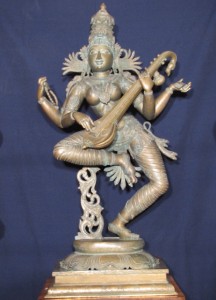 On more than one occasion White shared with friends his frustrations in dealing with museum administrators in India. In a Bangalore museum he saw a large collection of paintings in rolls in a musty basement. When he broached organizing an exhibition of the paintings (paying from his resources for insurance, shipping, framing them for display), the museum director asked him for a business class ticket for him and his wife.
On more than one occasion White shared with friends his frustrations in dealing with museum administrators in India. In a Bangalore museum he saw a large collection of paintings in rolls in a musty basement. When he broached organizing an exhibition of the paintings (paying from his resources for insurance, shipping, framing them for display), the museum director asked him for a business class ticket for him and his wife.
The Hunt Library organized a memorial service to James White on May 20 at CMU. In White’s death, the Indian Diaspora in Pittsburgh lost a good friend.                                    —Â
Photo by Deepak Kotwal : The 48″ high Saraswati in Chola- style bronze from the private collection of Mr. Jim White, an Indophile. White passed away in April.
By Premlata Venkataraman.
Sri Sathya Sai Baba: Godman with difference.
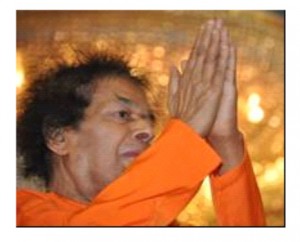 Sri Sathya Sai Baba was a unique spiritual figure of our times, whose teachings transcended linguistic, social, national, and even religious barriers. His message was simple and universal: “Love all, serve all.† He said,†I have not come on behalf of any exclusive religion. I have not come seeking publicity for a sect, creed, or cause; nor have I come to collect followers for a doctrine. I have come to establish Sanathana Dharma (the Eternal Order).†Â
Sri Sathya Sai Baba was a unique spiritual figure of our times, whose teachings transcended linguistic, social, national, and even religious barriers. His message was simple and universal: “Love all, serve all.† He said,†I have not come on behalf of any exclusive religion. I have not come seeking publicity for a sect, creed, or cause; nor have I come to collect followers for a doctrine. I have come to establish Sanathana Dharma (the Eternal Order).†Â
 People of all faith came to him. One did not have to abandon his or her religion to be his follower. He said, “Let the different faiths exist, let them flourish, and let the glory of God be sung in all the languages and in a variety of tunes.† One did not even have to be believer to acknowledge the phenomenon he has been.
What attracted me personally most was his legacy of service. Miracles were second nature to him. His mission was to serve the “poorest of the poor†all across the globe, from the tiny hamlet of Puttaparthi to the remote corners of the world. He established state-of-the-art super specialty hospitals, general hospitals, clinics — even mobile hospitals for those who could not come to the hospitals.
The hospitals provide basic and advance healthcare free of charge to all. Patients received both “Dava and Duaâ€as Prime Minister Vajpayee, his devotee, said inaugurating his Banglore Hospital.
He always said, â€Serving hands are holier than praying lips.â€Â Such was the quality of in his mission hospitals that they model many governments and NGOs wonder how he makes it work. Even WHO sent a special team to study the workings of his hospitals and model the team was pleasantly surprised on how effectively managed they were.
Sai Baba also started an education system “EHV†Education in Human Values, which include Sathya, Dharma, Shanti, Prema and Amhinsa, (or Truth, Fairness, Peace, Compassion, and Nonviolence) which was readily adopted in many school curricula including in schools in Muslims countries like UAE.
One of his famous sayings was: “If there is righteousness in the heart, there will be beauty in the character. If there is a beauty in the character, there will be harmony in home. When there is a harmony in home, there will be order in the nation. When there is an order in the nation, there will be peace in the world.†When India’s ex-President Abdul Kalaam, another devout follower, quoted this passage while addressing the European Parliament, there was an unprecedented thundering ovation after this quote.
No amount of words or space can describe his true glory. Of course, detractors are always there against any divine being in any age. Some even question his timing of leaving his body. Actually, he left his body at the precise age of 96 according to Vedic Lunar calendar not Gregorian calendar.
That he was the source of inspiration to the building of so many hospitals and educational institutions, and making them accessible to the really poor was perhaps the most tangible of all the miracles.
 I believe he is what he said he was — a divine being in human form.
East Meets West
By Mandira Chattopadhyay   Â
e-mail: mchattopadhy@bsu.edu
Many years ago, Kipling remarked, “Oh, East is East, and West is West, and never the twain shall meet.”
Priyanka visited the wedding ceremonies as an outsider, to collect data for her anthropological research. She reckoned that as an invited guest for the wedding, she could use this as an opportunity to perform an ethnographic study of this event and the people around it. The son of a well-to-do Bengali immigrant, the groom was born in Calcutta but brought up mostly in southern New Jersey, chose a Midwestern all American girl who came to study at a nearby college and then became a school teacher. The groom, after graduating from a local college, picked the prestigious location of Princeton, New Jersey to build up his business.
The wedding definitely embraced a bourgeois lifestyle as the couple appeared in an unmistakably Western manner in a Princeton Chapel. The groom gazed with reverence and admiration at the bride, who with her blonde hair and blue eyes returned her glance to him on a beautiful sunny April morning. As the bride walked down the aisle in her father’s arms, the groom appeared in his diamond-buttoned tuxedo. It was definitely a sight to see how the new generation of Indians was melding into the American way of life.Â
 Some of the Indian women started to make catcalls, known as Uludhwani to mark the religious occasion, while some others began to blow soap bubbles. The priest performed the wedding rites by first starting a small fire from the wedding kit he brought. He then explained the series of events that followed as he chanted the Hindu religious verses in Sanskrit.Â
Priyanka remembered her own wedding in Princeton, N.J., a number of years ago where she had met her beau, an Indian graduate student at Princeton University. She had come from India just three months ago to visit her sister who lived near Princeton. The priests were not easy to find then, the only one available was hurriedly brought from the Indian Consulate in New York City. A traditional Indian wedding took place in her sister’s residence – a blazing fire was set up in the backyard with the flames rising up in the sky.  Wedding vows were taken with the fire representing the almighty as the witness, and the bride and the groom went around the fire. Unfortunately the bride and the groom could not wear on Indian style wedding hats, because they were not available. Indian food was served in her sister’s backyard. The reception followed the next day at the Princeton University Graduate College, where everyone, Indians and Americans alike, dressed up in Indian clothes. It seemed that East still remained the East.Â
Priyanka imagined how in her own wedding she was bonded to the people that worked so hard for her wedding, a bond that remained with her even to this day.Â
Looking at this wedding, she concluded that Kipling was wrong after all. The East and the West have truly met, and what a mingling it was, at this gala and lavish wedding.
Universal Ideas in the 1800-years old Tamil Literature
By Kollengode S. Venkataraman
Many of you may know that Tamil devotional literature – over 10,000 verses composed by Saiva and Vaishnava poets between 4th and 10th centuries AD — was the trigger for the Bhakti poetry in all Indian languages in later centuries that forever enriched and defined the Indian psyche.
Even before the advent of the Bhakti poetry, anthologies of secular Tamil poems written between 1st and 4th centuries AD are in what is called the Sangam Literature. One well-known is Aga-Naanooru (literally, Internal-400) with sensual love as its motif. The second is Pura-Naanooru (or External 400) focusing on events outside the love life of people. The “400†is the approximate number of verses in the anthologies.
Pura-naanooru’s poems describe the valor, generosity, even tyranny, of kings. The poets advise kings against going to war, mediate fights between neighboring kings, criticize kings on the excesses of corrupt officials, admonish kings to be loyal to their wives and not philander, exhort people to be benevolent — the same themes we see in public life today. Many are also sycophantic, jingoistic, and describe poverty among people — traits that are common today as well.
However, one poem in Pura-Naanooru by Kaniyan Poonkunran, known to those familiar with Tamil classics, stands out. This poem is breathtakingly fresh and “modern†given that it is written over 1800 years ago. Here is Prema Venkataraman’s attempt to versify the poem from its literal translation:
Every hamlet is my village and all are my kin; Good and bad are caused not by others herein. Natural is the flow of angst, And the happy event next. Through all of which we know, Death is nothing new.  So happy events do not make us exultant; And difficulties neither make us despondent.  “The rain batters the hill with lightning and thunder; Rain drops become streams, and thence to a gushing river. As the river meanders, the canoes go with its flow. With the ebb and flow of life, like the canoes we go.† This we learned from the wise among us. So we neither gape with awe at those who are famous; Better still, nor we disdain those who are nameless. ÂKaniyan Poonkunran’s opening words resonate well in today’s globalized world. Better still, in a world given to adulation of wealth, success, power, and fame, his words towards the end make us think, guiding us on how we need to model our lives. Here is the original for those who can read Tamil: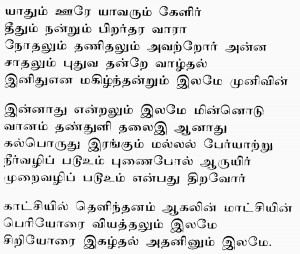
Ummm or is it “Ha”
What follows is my conversation with an operator in the plant several years ago — K S Venkataraman.
“Venkat, Where are you from?”
“How far back you want me to go?
“I mean, where are you originally from?
“India, Mike.”
“How far is it from here?”
“Oh, over 10,000 miles.”
“How long does it take to fly over there?”
New Gingrich in His Own Words:
Newt Gingrich, the Republican ex-House Speaker, wanting to become the US President, on CBS’s Face the Nation, May 22, 2011
GINGRICH: You know, we don’t do elaborate things.
BOB SCHIEFFER, the CBS moderator of Face the Nation: Did you owe half-million dollars to a jewelry company at one point?
Newt: We had a revolving fund.
Bob: Well, what does that mean?
Newt: It means that we had a revolving fund. It was a… …
Bob: I mean, who buys a half-million dollars worth of jewelry on credit?
Newt: No. It’s a… … go talk to Tiffany’s. It’s a standard, no-interest account.
Bob:: How long did you owe it?
Newt: I have no idea, but it was paid off automatically. We paid no interest on it. There was no problem with it. It’s a normal way of doing business.
Bob: Well, I mean, it’s very odd to me that someone would run up a half-million-dollar bill at a jewelry store.
Newt: Well, go talk to Tiffany’s. All I’m telling you is we are very frugal. We, in fact, live within our budget. We owe nothing.
